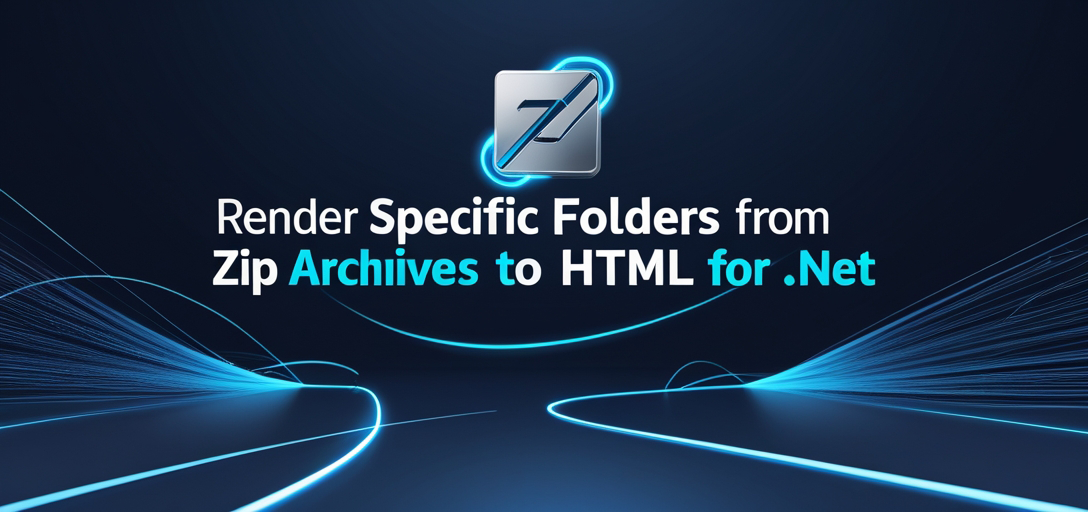Tutorial: Implementing GroupDocs.Viewer .NET to Render Specific Folders from ZIP Archives to HTML
Introduction
In this tutorial, you’ll learn how to use GroupDocs.Viewer .NET to extract specific folders from a ZIP archive and render them as HTML files. This is an efficient way to focus on rendering selected content within an archive.

What You’ll Learn:
- Setting up GroupDocs.Viewer in a .NET environment
- Rendering specific folders from ZIP archives as HTML files
- Configuring view options for optimal results
Let’s start by ensuring you have the necessary prerequisites!
Prerequisites
Before proceeding, ensure you have:
- .NET Development Environment: Visual Studio with support for C#.
- GroupDocs.Viewer Library: Version 25.3.0 or later of GroupDocs.Viewer for .NET.
Required Libraries and Dependencies
To use GroupDocs.Viewer, install the package via one of these methods:
NuGet Package Manager Console
Install-Package GroupDocs.Viewer -Version 25.3.0.NET CLI
dotnet add package GroupDocs.Viewer --version 25.3.0
Environment Setup
Ensure your development environment is set up with the .NET SDK and Visual Studio, which you can download from the official Microsoft website.
Knowledge Prerequisites
A basic understanding of C# programming and experience with .NET applications will be beneficial. Familiarity with handling files and directories in a .NET context is helpful but not essential.
Setting Up GroupDocs.Viewer for .NET
Installation
Integrate the GroupDocs.Viewer library into your project using one of the methods above to ensure all dependencies are correctly configured.
License Acquisition
GroupDocs offers several licensing options:
- Free Trial: Download a trial version from here.
- Temporary License: Apply for a temporary license if you need full access without limitations for evaluation purposes.
- Purchase License: For production use, purchase a license through their website.
Basic Initialization and Setup
Initialize GroupDocs.Viewer in your C# application like this:
using System;
using GroupDocs.Viewer;
// Initialize viewer object with an archive file path
using (Viewer viewer = new Viewer("YOUR_DOCUMENT_DIRECTORY/SAMPLE_ZIP_WITH_FOLDERS.zip"))
{
// Proceed with setting options and rendering...
}
Implementation Guide
Now, let’s render specific folders from a ZIP archive.
Rendering Archive Files
Set up GroupDocs.Viewer to render an entire folder within an archive file as HTML.
Step 1: Setup Output Directory
Define the location for your rendered files:
string outputDirectory = "YOUR_OUTPUT_DIRECTORY";
string pageFilePathFormat = Path.Combine(outputDirectory, "page_{0}.html");
This setup specifies where and how output HTML pages will be named.
Step 2: Configure Viewer Options
Next, configure the viewer to render with embedded resources:
using GroupDocs.Viewer.Options;
HtmlViewOptions options = HtmlViewOptions.ForEmbeddedResources(pageFilePathFormat);
options.ArchiveOptions.Folder = "ThirdFolderWithItems";
HtmlViewOptions: Configures the rendering process.ForEmbeddedResources: Ensures all resources are embedded directly into the HTML.ArchiveOptions.Folder: Specifies which folder within the archive to render.
Step 3: Render the Folder
Use the Viewer object with your configured options:
using (Viewer viewer = new Viewer("YOUR_DOCUMENT_DIRECTORY/SAMPLE_ZIP_WITH_FOLDERS.zip"))
{
viewer.View(options);
}
Troubleshooting Tips
- Verify that the archive path and folder names are correct.
- Ensure you have permissions to read the archive and write to the output directory.
Practical Applications
This feature can be beneficial in scenarios like:
- Document Management Systems: Convert specific folders within ZIP archives into HTML for web display.
- Email Attachments Viewer: Render attachments from email zip files selectively for previews.
- Archiving Solutions: Extract and view specific document types or categories within larger archive files.
Performance Considerations
To optimize performance:
- Use caching mechanisms to avoid re-rendering the same content.
- Ensure efficient memory management by disposing of viewer objects promptly after use.
Conclusion
In this tutorial, you’ve learned how to configure GroupDocs.Viewer .NET to render specific folders from ZIP archives as HTML. This functionality is a powerful tool for various applications, offering flexibility and efficiency in document handling.
To further your skills, explore more features offered by GroupDocs.Viewer or integrate it with other frameworks for enhanced capabilities.
FAQ Section
Can I use this feature with other archive formats?
- Yes, GroupDocs.Viewer supports multiple archive types such as TAR, RAR, and 7z.
What if the specified folder does not exist in the archive?
- The viewer will throw an exception; ensure the folder path is correct.
How can I handle large archives efficiently?
- Consider rendering specific pages or using asynchronous operations to manage resources better.
Is it possible to customize the HTML output?
- Yes, you can modify styles and scripts within the generated HTML files post-rendering.
What are some common errors encountered during setup?
- Common issues include incorrect paths, missing dependencies, or insufficient permissions.
Resources
- Documentation
- API Reference
- Download GroupDocs.Viewer for .NET
- Purchase Licenses
- Free Trial
- Temporary License
- Support Forum
Take the next step and try implementing this solution in your project today!